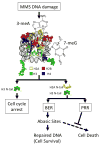Nucleosomes Regulate Base Excision Repair in Chromatin
- PMID: 31388331
- PMCID: PMC6684245
- DOI: 10.1016/j.mrrev.2017.10.002
Nucleosomes Regulate Base Excision Repair in Chromatin
Abstract
Chromatin is a significant barrier to many DNA damage response (DDR) factors, such as DNA repair enzymes, that process DNA lesions to reduce mutations and prevent cell death; yet, paradoxically, chromatin also has a critical role in many signaling pathways that regulate the DDR. The primary level of DNA packaging in chromatin is the nucleosome core particle (NCP), consisting of DNA wrapped around an octamer of the core histones H2A, H2B, H3 and H4. Here, we review recent studies characterizing how the packaging of DNA into nucleosomes modulates the activity of the base excision repair (BER) pathway and dictates BER subpathway choice. We also review new evidence indicating that the histone amino-terminal tails coordinately regulate multiple DDR pathways during the repair of alkylation damage in the budding yeast Saccharomyces cerevisiae.
Figures






Similar articles
-
Histone variants H3.3 and H2A.Z/H3.3 facilitate excision of uracil from nucleosome core particles.DNA Repair (Amst). 2022 Aug;116:103355. doi: 10.1016/j.dnarep.2022.103355. Epub 2022 Jun 12. DNA Repair (Amst). 2022. PMID: 35717761 Free PMC article.
-
[Initial stages of DNA Base Excision Repair in Nucleosomes].Mol Biol (Mosk). 2021 Mar-Apr;55(2):194-209. doi: 10.31857/S0026898421020087. Mol Biol (Mosk). 2021. PMID: 33871435 Review. Russian.
-
A chromatin scaffold for DNA damage recognition: how histone methyltransferases prime nucleosomes for repair of ultraviolet light-induced lesions.Nucleic Acids Res. 2020 Feb 28;48(4):1652-1668. doi: 10.1093/nar/gkz1229. Nucleic Acids Res. 2020. PMID: 31930303 Free PMC article.
-
The amino-terminal tails of histones H2A and H3 coordinate efficient base excision repair, DNA damage signaling and postreplication repair in Saccharomyces cerevisiae.Nucleic Acids Res. 2015 May 26;43(10):4990-5001. doi: 10.1093/nar/gkv372. Epub 2015 Apr 20. Nucleic Acids Res. 2015. PMID: 25897129 Free PMC article.
-
Histone variants: The unsung guardians of the genome.DNA Repair (Amst). 2022 Apr;112:103301. doi: 10.1016/j.dnarep.2022.103301. Epub 2022 Feb 17. DNA Repair (Amst). 2022. PMID: 35220000 Free PMC article. Review.
Cited by
-
DNA Data Storage.BioTech (Basel). 2023 Jun 1;12(2):44. doi: 10.3390/biotech12020044. BioTech (Basel). 2023. PMID: 37366792 Free PMC article. Review.
-
Exploiting DNA Endonucleases to Advance Mechanisms of DNA Repair.Biology (Basel). 2021 Jun 14;10(6):530. doi: 10.3390/biology10060530. Biology (Basel). 2021. PMID: 34198612 Free PMC article. Review.
-
Generation of Recombinant Nucleosomes Containing Site-Specific DNA Damage.Methods Mol Biol. 2023;2701:55-76. doi: 10.1007/978-1-0716-3373-1_4. Methods Mol Biol. 2023. PMID: 37574475 Free PMC article.
-
Histone variants H3.3 and H2A.Z/H3.3 facilitate excision of uracil from nucleosome core particles.DNA Repair (Amst). 2022 Aug;116:103355. doi: 10.1016/j.dnarep.2022.103355. Epub 2022 Jun 12. DNA Repair (Amst). 2022. PMID: 35717761 Free PMC article.
-
The impact of epigenetic information on genome evolution.Philos Trans R Soc Lond B Biol Sci. 2021 Jun 7;376(1826):20200114. doi: 10.1098/rstb.2020.0114. Epub 2021 Apr 19. Philos Trans R Soc Lond B Biol Sci. 2021. PMID: 33866804 Free PMC article. Review.
References
-
- Friedberg EC, Walker GC, Siede W, Wood RD, Schultz RA, Ellenberger T. DNA repair and mutagenesis. 2. ASM Press; Washington, D.C: 2006.
-
- Bernstein C, Prassad AR, Nfonsam V, Bernstein H. DNA Damage, DNA Repair and Cancer. In: Chen CC, editor. New Research Directions. Intech, open access; 2013. pp. 413–465.
Publication types
MeSH terms
Substances
Grants and funding
LinkOut - more resources
Full Text Sources
Molecular Biology Databases
